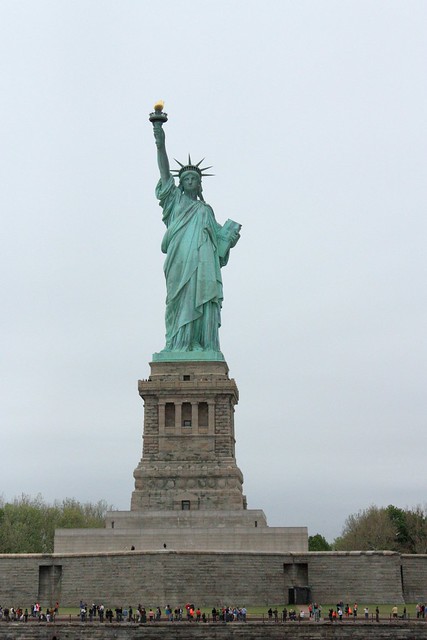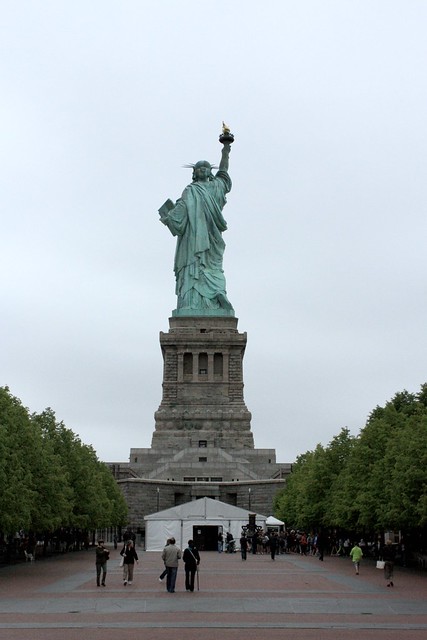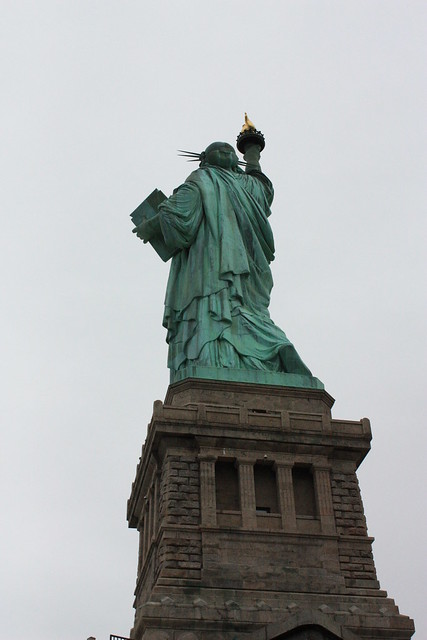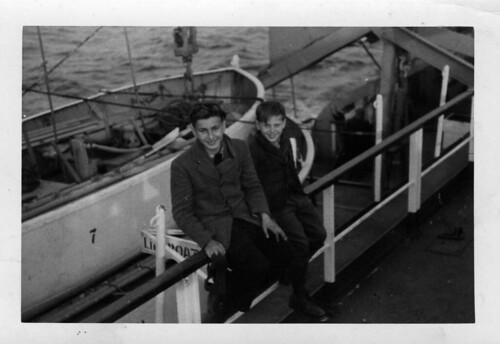The Statue of Liberty and Ellis Island: Part I
(Note: Due to length, I’ve split up my coverage of the Statue of Liberty and Ellis Island into two posts. Part 1 covers the Statue of Liberty, and Part 2 will be published tomorrow, and will cover Ellis Island. Enjoy.)
—————

Hanging out with my lady liberty.
–
I am not one to feel emotionally moved very often. This is probably on account of my heart being a brittle lump of coal. It is hard, black, and basically a pollutant.
I first became aware of said coal-heartedness during my senior year of high school. Titanic had just come out, and most of the female population of my school was in some strange teenage mass hysteria over it.
I wasn’t very interested in the movie myself, as I was pretty sure I knew how it ended. I managed to avoid it until late that summer, when a friend suckered me into seeing it at the drive-in by telling me we were going to Austin Powers (Chris, if you are reading this, you are an unmitigated ass. Call me.) Determined to not be the only one having a miserable time, I spent most of the movie ridiculing the characters, and by the final scene (WARNING: major spoiler on the way. But if you aren’t familiar with the top films of 1998, then perhaps you should get on that.) I was downright incredulous.
“Seriously? She’s going to let him freeze to death? There isn’t room on that plank of wood for him? It’s the size of a tennis court.”
“Shhhhhh!” someone hissed.
And then, when Rose breaks Jack’s frozen fingers off of hers (dear god, how was this a movie?) and he sinks into a watery abyss, I began to laugh uncontrollably, because it was just so … so … much. I am certain this display of giggling proves that I am a soulless, evil shrew.
Or maybe it proves that it takes more than an idiotic blockbuster to compel me to tears.
How much more? Approximately one trip to each the Statue of Liberty and Ellis Island. That’s more than sufficient to reduce me to a emotional wreck, and yet I don’t know if I’ve enjoyed visiting any two historical sites more.
I decided to go on a whim – I had a free day in New York and Rand was busy with appointments. Day-of tickets were no longer being sold on the website, so I called, spoke to an actual human being, and had a ticket waiting for me at will-call. I was unable to get “Monument access” and would only be able to view the statue from its base, due to my last-minute planning. Should you go for yourself, plan massively ahead. As of May, the next available monument pass was early September, and in November of this year, the statue will be closed entirely for renovations (you’ll still be able to walk around the island, like I did).
Both the website and the gal on the phone warned me to get down to the ferry terminal in Battery park early. My ticket was for noon, and if I was not through their airport-like security gate by that time, I would not be let on the boat, I’d be out the price of a ticket, and I’d have seven years of bad sex (give or take). Much panicked by these threats, I arrived a half hour early and discovered that doing so was a waste of time. The gentleman behind me in line had a ticket that had expired an hour earlier, but he made it through without incident (I have not touched base with him about the quality of the sex he’s been having since). While the line was long, it moved quickly and everyone was rather polite. Shoving and farting were kept to a minimum.

The lines are bad, but not terrible. Think Epcot, not Disney.
–
There were signs that noted “airport-style security ahead”, which also proved inaccurate. Yes, there were metal detectors and bags were x-rayed. But the security agents smiled and flirted with guests, there were no back-scatter machines, and not a single person was patted down. It was like I had died and gone to the late 90s.
We loaded onto ferries. Mine was christened the SS Ellis Island, a name which is impossible to say out loud without coating the folks next to you in a gentle spray of saliva.

Try saying it three times fast without drenching your monitor in spittle.
–
There was a rush to the top of the boat as everyone tried to secure a seat, but within 10 minutes of having left the dock, the cold had driven them to the bowels of the boat. As a lifetime in Seattle has made me impervious to overcast, chilly weather, I stayed up top and snapped some photos.
The views of Battery park are pretty fantastic, and you can get lots of pictures of people taking pictures of the skyline.

–
And then, after a short, chilly trip across the harbor, she appeared.
 –
–
And she was lovely.
 –
–
I’ve heard time and again that the Statue of Liberty is smaller in real life than many people expect her to be, but I wasn’t really surprised or disappointed in her stature. Perhaps it’s because the same thing has been said of me.
“I didn’t realize you’d be so short,” people often tell me. And I shrug, because I don’t think it’s sufficient ground for someone to feel let down.
Liberty Island, on which she stands, isn’t terribly big, and is incredibly easy to navigate, even for someone like me (that is, with the sense of direction of a moth with an ear infection). As soon as I stepped off the boat, I found the audio tour kiosk and picked up a headset for which I had prepaid when I got my ticket. I truly cannot recommend the audio tour enough – especially if you are like me, and your knowledge of the Statue of Liberty does not extend much beyond a.) the fact that it was a gift from the French, in what was clearly their last kind act towards Americans, and b.) what you are able to glean from Ghostbusters II.
The tour actually has you approach the statue from behind, so you sort of feel like you are sneaking up on her.

She suspected nothing.
–

"We should have padded her feet!" / "I don't think they make Nikes in her size, Ray."
–
She was intended as a gift to commemorate the friendship that grew between America and France during the American Revolution, to coincide with the 100th birthday of the United States. We provided the base, and France provided the statue (a deal of which we truly got the better end: “All we have to do is make a pedestal, and we get to keep the statue? Sweet.”). Due to numerous financial difficulties for both countries, it was finished ten years behind schedule, in 1886.
I hadn’t quite made it around to the front of the statue when I noticed a National Park Ranger giving a free tour, which I immediately joined. Though I’m sure he’d given his tour hundreds of times before, he spoke of the Statue of Liberty tenderly, like an old lover still held dear. On the criteria of facts, he provided me with no information that the audio tour did not. But seasoned by his honeyed voice (he was from the south originally – Louisiana, I think) these facts were now more palatable than they had been when I heard them over my headset.
He spoke of how Eiffel, fresh of the success of his eponymous tower, had designed the armature for the statue and how she had been shipped to the U.S. in pieces. How in her flowing Grecian robes she reminded us of democracies of old. How she stepped upon on the chains of tyranny and held her torch over the harbor, bringing the light of liberty to the old world, beckoning the people: Come.
He told the story of the immigrants who built the cities that their children would later govern. And when a woman asked him about the current debate on immigration, how it was so different from the tenants of old, he replied, simply: we have lost touch with the principals on which this country was built.
And with that, and a gentle command that we should continue to explore Liberty Island on our own, he concluded the tour and said good-bye.
I did as he said, slipping my headphones on and continuing my walk, until I finally found myself face-to-base with the Statue of Liberty.
At that precise moment, the audio tour narrator began to recite Emma Lazarus’s poem, The New Collosus. Prior to that day, I had not heard the poem in its entirety before. But on that overcast afternoon I listened to it no less than three times.

"A mighty woman with a torch, whose flame is the imprisoned lightning, and her name Mother of Exiles."
–
Mother of Exiles. Caretaker of the unloved, the unwanted, the displaced.
She was there, I thought, when my mother’s grandfather came to American nearly a century ago. He left his family in Italy, promising to come back for them after he had secured a job, but he was never able to. He became ill and died in New York, leaving my great-grandmother and her daughters (one of whom was my grandmother) in Italy. It would take my grandmother another fifty years to finally come to America – she was the only one of her sisters who would make the move.
Send these homeless, tempest-tost to me.
I thought of my dad, crossing Europe in the back of train cars as he and his mother and brother made their way from Russia to Germany. And I remembered photo of him on the docks in New York. He was not “just off the boat.” Indeed, he was still on it:

My father, left, with my uncle at right. New York, circa 1950.
–
I never asked my dad about what he thought when he first landed in New York. I can’t quite get an answer out of him. He simply goes on about Katz’s Delicatessen and their pastrami, and I accept that I’ll never hear how he looked at the Statue of Liberty and thought, I am home. Because realities like that don’t exist in my family’s history. Maybe they noticed her. Maybe they did not. But she was there for all of it.
And for some reason, this idea wrecked me to the core. That she saw my great-grandfather’s arrival, along with so many other great-grandfathers, less ill-fated than my own. When I looked at her, despite the cynicism that pervades my very soul, despite a heart forged from brittle coal, I may have shed a tear or two.
Or twenty. I’m not keeping track.
Ellis Island was next, and I foolishly hoped it would give me some reprieve. A bit of a break from the turmoil in my head, from heavy thoughts of what it means to be an American. Of my family’s own history of immigration. That I would stop thinking of my relatives who were born in small towns in Europe and laid to rest in cities in America, far from where they started out.
As usual, I was miserably wrong. Ellis Island was about to leave me more distraught than The Statue of Liberty ever could. But that’s a tale for tomorrow.









Leave a Comment